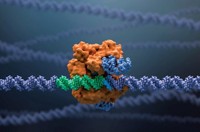Advertisement
Grab your lab coat. Let's get started
Welcome!
Welcome!
Create an account below to get 6 C&EN articles per month, receive newsletters and more - all free.
It seems this is your first time logging in online. Please enter the following information to continue.
As an ACS member you automatically get access to this site. All we need is few more details to create your reading experience.
Not you? Sign in with a different account.
Not you? Sign in with a different account.
ERROR 1
ERROR 1
ERROR 2
ERROR 2
ERROR 2
ERROR 2
ERROR 2
Password and Confirm password must match.
If you have an ACS member number, please enter it here so we can link this account to your membership. (optional)
ERROR 2
ACS values your privacy. By submitting your information, you are gaining access to C&EN and subscribing to our weekly newsletter. We use the information you provide to make your reading experience better, and we will never sell your data to third party members.
Investment
FDA prepares for huge growth in cell and gene therapy
The agency anticipates hundreds of new applications for cell and gene therapy in coming years
by Ryan Cross
January 16, 2019
| A version of this story appeared in
Volume 97, Issue 3
The US Food and Drug Administration says it is preparing for a coming wave of experimental cell and gene therapies. By 2020, the agency expects it will see more than 200 applications a year requesting permission to begin cell and gene therapy trials. The agency already has more than 800 such applications on file and plans to hire some 50 clinical reviewers to handle the surge.
10–20:
Cell and gene therapies the FDA anticipates approving per year by 2025
50:
New clinical reviewers the FDA says it will hire
200:
Cell and gene therapy investigational new drug applications the FDA expects to see per year by 2020.
So far, only three cell and gene therapies are approved for sale. In 2017, the first two genetically engineered cell therapies, the CAR T-cell treatments Kymriah and Yescarta, were approved for a small group of people with certain blood cancers. That year, the FDA also approved the US’ first bona fide gene therapy, Luxturna, which uses an adeno-associated virus (AAV) to deliver a healthy copy of DNA to treat a rare form of inherited blindness.
Those successes marked a transition for the field from experimental to commercial. In a statement, FDA Commissioner Scott Gottlieb and the director of the Center for Biologics Evaluation and Research, Peter Marks, write that the turning point is reminiscent of the antibody drug field in the late 1990s, which was hastened by the development of antibodies that weren’t rejected by the human body. Likewise, the gene-therapy field has benefited from the establishment of AAVs that can shuttle genes into cells without eliciting deadly immune reactions, Gottlieb and Marks say.
By 2025, the two predict, the FDA may approve 10–20 new cell and gene therapy products a year.
Despite slow first-year sales for Luxturna, Kymriah, and Yescarta, big drug and biotech company interest in cell and gene therapies exploded last year. Novartis acquired the gene-therapy company AveXis for $8.7 billion, and Celgene bought the CAR T-cell company Juno Therapeutics for $9.0 billion. At the turn of 2019, Bristol-Myers Squibb announced it would add Juno’s CAR T-cell assets to its pipeline through a proposed $74 billion megamerger with Celgene.
The industry anticipates several key readouts of ongoing clinical trials during 2019, and the field was a hot topic during the recent J.P. Morgan Healthcare Conference in San Francisco. “This year is going to be huge,” Ken Mills, CEO of the gene-therapy company Regenxbio, told C&EN at the meeting. His company licensed an AAV to AveXis for its experimental spinal muscular atrophy treatment. The gene therapy has shown promising results in treating the normally deadly genetic condition in children, and Novartis anticipates that the FDA will approve it this year.
Advertisement
According to the Alliance for Regenerative Medicine—an industry group that represents cell therapy, gene therapy, and tissue engineering companies—the sector raised $2.9 billion in venture capital in 2018, twice the 2017 amount. And start-ups raised some $1.9 billion in initial public offerings, more than double the previous two years combined.
Players expect even more activity in 2019. “I don’t think the Novartis acquisition of AveXis is the only one that is going to occur,” Mills said about gene therapy. “I think big pharma is starting to wrap their minds around cell and gene therapy not only being an important part of their R&D, but their commercial portfolio too.”



Join the conversation
Contact the reporter
Submit a Letter to the Editor for publication
Engage with us on Twitter